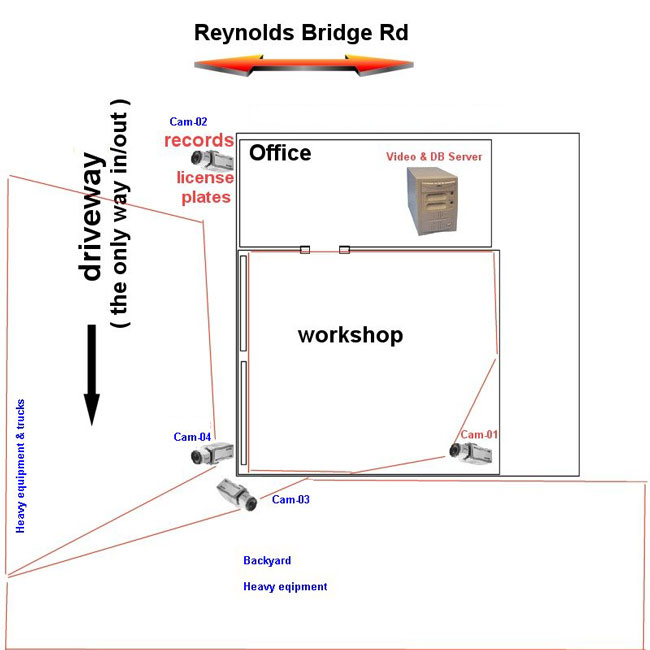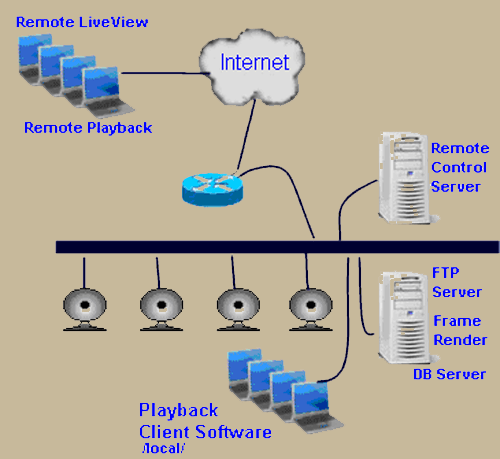
The ABCO Construction Surveillance System
Martin Jordan
Dale R. "Zy" Fox
| This case is based on Martin Jordan's experience running his own small business. Martin got involved with computer networks and video surveillance systems from working with his parent's small business. He has since branched out to work for others. I am putting the case together, though basically everything is coming from Martin. Some things have been altered to make sure no one knows all that much about the actual business. |
| Some Background.
ABCO is a fairly small construction company that specializes in
building things like garages, decks and additions on homes.
They have a construction yard in Middletown, CT. This yard is
large enough to justify having four
surveillance cameras. They have had things like
automobiles disappear from the yard even with the cameras installed! The cameras have been installed so to maximize coverage of important areas. This is represented in the following diagram. |

| The Cameras. The cameras have been positioned in terms of
distance above the ground, direction and range so that the entire
yard is covered, with the most important things having coverage from
at least two angles. Three of the actual cameras that are used are made by IQinvision. The other is made by Panasonic.
Several of the main competitors in this market are IQinvision, Sony, Panasonic, Toshiba, Axis Communications and Visual Data. In order to use these over a computer network the video streams from the cameras are broken up into JPEGs. These JPEGs are typically between 35KB and 200KB. Though for HDTV they can be more on the size of 900KB with resolutions of 1280 x 720 pixels. To give you a sense of the bytes of information that need to be transmitted over the network you also need to know how many frames or JPEGs need to be transmitted per second. Some possibilities are listed in the following table. |
| frame size | frames/sec | Mbps/camera |
| 35KB | 7 | 1.9140 Mbps/camera |
| 200KB | 7 | 10.9375 Mbps/camera |
| 900KB | 2 | 14.0625 Mbps/camera |
| The calculation for the conversion of the 200KB images follows. You want to make sure to notice the use of the units. |

| So you can see that you can get quite a few
cameras on a switches Fast Ethernet network without having a lot of
problems! ABCO can use their regular Fast Ethernet LAN to
handle the information associated with these surveillance cameras
and their internal operations. Though it is important to
remember how much information needs to be transmitted, particularly
once you want to monitor things more remotely via the Internet. It turns out that each of these network cameras has several built in capabilities. These capabilities are likely to be somewhat surprising at first blush, but then one realizes their importance.
It is also the case that each camera has its own static IP address. Though, they could likely be configured through DHCP by a DHCP server, this installation doesn't have a DHCP server. Database Storage. The video streams are fed via the 100Mbps Ethernet to a database server that allows later playback. This is done with a Terabyte Digital Video DB. Each frame is stored in the database. These streams/frames are retained for 30 days. Something called FrameRender retrieves each individual JPEG and drops it in the BLOB field of the DB record. The record structure:
The DB consists of multiple DBF tables. Each table up to 2 GB. The DB serves as input for the Playback module. The Network. The logical network diagram for ABCO Construction is given in the following image. This diagram focuses on the surveillance portion of the network and the desire to get remote playback via the Internet. There is a firewall to protect the internal network. Network authentication is used internally to help protect the systems. |

| When off premises, something
called RemoteControl is used to view surveillance
information. Obviously, there are issues about
getting such streams to move well across the open
Internet. For starters, the connection the business has to the Internet is a DSL line. It doesn't seem to have any unusual upload capacities associated with trying to stream video/frames offsite. There are also issues of what sort of feed is available at the location where remote playback is desired. Though, most DSL connections are asymmetrically configured to give better download than upload bandwidth and this will work in favor at this end. In between, we have the Internet itself, with unknown capacity. Is it worth it for the business to lease some capacity? |